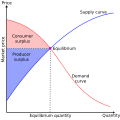Talk:Bank of England
| This is the talk page for discussing improvements to the Bank of England article. This is not a forum for general discussion of the article's subject. |
Article policies
|
| Find sources: Google (books · news · scholar · free images · WP refs) · FENS · JSTOR · TWL |
| Archives: 1Auto-archiving period: 30 days |
| This article is written in British English, which has its own spelling conventions (colour, travelled, centre, defence, artefact, analyse) and some terms that are used in it may be different or absent from other varieties of English. According to the relevant style guide, this should not be changed without broad consensus. |
| This article is rated B-class on Wikipedia's content assessment scale. It is of interest to the following WikiProjects: | |||||||||||||||||||||||||||||||
| |||||||||||||||||||||||||||||||
| Text and/or other creative content from Bank of England was copied or moved into Central bank with this edit. The former page's history now serves to provide attribution for that content in the latter page, and it must not be deleted as long as the latter page exists. |
| A fact from this article was featured on Wikipedia's Main Page in the On this day section on July 27, 2008, July 27, 2013, and July 27, 2015. |
Reaction in the City
[edit]It was very popular with the City of London, showing a sign of the new government's desire for a strong economy. Following the announcement the FTSE 100 Index leapt rapidly. The pound reached its highest level against the Deutsche mark since Sterling's exit from the ERM.
These remarks don't hold up when viewing the data. The FTSE didn't move a significant amount given the volatility of the period. The move in May (2.7%) was smaller than the previous April (4.4%) or the subsequent move in June (3.7%) (Bloomberg). These moves are about 1 standard deviation, i.e. not unusual. Similarly for the pound/mark rate. There appears to be no reaction in May, the peak was reached in the end of July (a reaction to US rates news), and subsequently moved sideways/down. I suggest that at best the reaction "In the City" was mixed. —The preceding unsigned comment was added by 135.196.109.220 (talk • contribs). on 17 May 2006.
Nuestra Señora de la Concepción - Ambiguity?
[edit]The article notes William Phips's role in finding the treasure of the sunken Nuestra Señora de la Concepción, which paid a great return to William Paterson. The article links to https://en.wikipedia.org/wiki/Nuestra_Se%C3%B1ora_de_la_Concepci%C3%B3n, which is a 16th century ship sunk by Francis Drake. However, the Concepción that Phips recovered was apparently not built until 1620 and did not set sail until 1641, per this source: https://shiplib.org/index.php/shipwrecks/iberian-shipwrecks/spanish-and-the-new-world/nuestra-senora-de-la-concepcion-1641-2/ .
Is it possible there are two different Spanish ships using the same name? If not, could someone clarify how Drake pillaged the ship in 1580, yet there was still enough treasure in its wreck to be recovered in 1687? 199.94.1.20 (talk) 20:33, 1 April 2025 (UTC)
- Wikipedia articles that use British English
- B-Class Economics articles
- Mid-importance Economics articles
- WikiProject Economics articles
- B-Class United Kingdom articles
- Mid-importance United Kingdom articles
- WikiProject United Kingdom articles
- B-Class Finance & Investment articles
- Low-importance Finance & Investment articles
- WikiProject Finance & Investment articles
- Selected anniversaries (July 2008)
- Selected anniversaries (July 2013)
- Selected anniversaries (July 2015)


